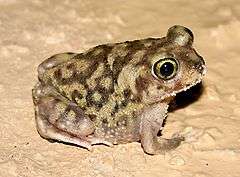Scaphiopus
| Scaphiopus | |
|---|---|
 | |
| Couch's Spadefoot Toad, Scaphiopus couchii | |
| Scientific classification | |
| Kingdom: | Animalia |
| Phylum: | Chordata |
| Class: | Amphibia |
| Order: | Anura |
| Family: | Scaphiopodidae |
| Genus: | Scaphiopus Holbrook, 1836 |

Scaphiopus is a genus of North American amphibian commonly referred to as the North American spadefoots, southern spadefoots, or eastern spadefoot toads.[1] They differ greatly from true toads (those of the family Bufonidae) by having eyes with vertical pupils, no parotoid gland, and relatively smooth skin. Their most distinctive feature is a spade-like projection on their hind feet, from which their common name is derived. This projection enables spadefoot toads to dig in loose soils with ease. Its scientific names means ‘spade-foot’ as well, from the Ancient Greek skaphís (σκαφίς, ‘spade, shovel’) and pous (πούς, ‘foot, leg’).[2][3]
Species
Scaphiopus species were once classified with their European cousins in the family Pelobatidae, but have since been reclassified to their own family, Scaphiopodidae with other North American species. There are three species in the genus Scaphiopus:[1]
- Couch's Spadefoot, Scaphiopus couchii Baird, 1854
- Eastern Spadefoot, Scaphiopus holbrookii (Harlan, 1835)
- Hurter's Spadefoot, Scaphiopus hurterii Strecker, 1910
Geographic range
Spadefoot toads are found throughout the United States and into northern Mexico. They tend to prefer dry, grassland areas with loose, sandy soils that flood in the rainy season.
Description
Scaphiopus are generally colored appropriately with greens and browns to camouflage themselves in their native habitat. At adult size they are usually not much larger than 8 cm.

Behaviour, diet, and reproduction
Spadefoot toads are nocturnal and are rarely seen when it hasn't rained recently. They spend most of the time during the dry season buried in the ground in aestivation. When it rains, they emerge to feed on invertebrates and to breed in vernal pools. They have one of the fastest reproductive cycles of any amphibian species. Once laid, eggs hatch in a matter of a day or two. The tadpoles are capable of developing to froglets within a couple of weeks. This feature is primarily due to fact that most of their breeding areas dry quickly once the rainy season is over.
Related species
Genus Spea, Western Spadefoot Toads
- Plains Spadefoot, Spea bombifrons (Cope, 1863)
- Western Spadefoot Spea hammondii (Baird, 1859)
- Great Basin Spadefoot, Spea intermontana (Cope, 1883)
- Mexican Spadefoot, Spea multiplicata (Cope, 1863)
References
- 1 2 Frost, Darrel R. (2015). "Scaphiopus Holbrook, 1836". Amphibian Species of the World: an Online Reference. Version 6.0. American Museum of Natural History. Retrieved 4 January 2016.
- ↑ σκαφίς. Liddell, Henry George; Scott, Robert; A Greek–English Lexicon at the Perseus Project
- ↑ Dodd, C. Kenneth (2013). Frogs of the United States and Canada. 1. The Johns Hopkins University Press. p. 20. ISBN 978-1-4214-0633-6.
- "Scaphiopus". Integrated Taxonomic Information System. Retrieved 11 January 2007.